
Daylight saving time (DST) is the practice of advancing the clocks by one hour during the summer months to make better use of the natural daylight.
However, this practice has many drawbacks that outweigh its benefits.
Therefore, we here at EDS argue that the United States should stop the regular twice yearly time change and lock the time permanently in DST mode.
But DST is mostly harmless isn’t it?
No!
DST disrupts the circadian rhythm (sleep cycle) of humans and animals, which can have negative effects on health and well-being.
According to a study by the American Academy of Neurology, the transition to DST in the spring is associated with an increased risk of ischemic stroke, especially in the first two days after the change
Another study by the University of Colorado Boulder found that the spring forward to DST leads to a 6% increase in fatal car accidents in the US, due to the loss of sleep and the disruption of the biological clock.
DST also affects the sleep quality and mood of millions of people, who may experience fatigue, irritability, depression, and cognitive impairment.
Moreover, DST can interfere with the natural rhythms of wildlife, such as birds, insects, and mammals, who rely on the sun for navigation, feeding, mating, and migration.
What about energy savings?
DST does not save energy, as it was originally intended to do.
The main rationale for DST was to reduce the use of artificial lighting and heating during the evening hours, and thus save energy and resources.
However, modern society uses more energy for other purposes, such as air conditioning, computers, TVs, and appliances, regardless of the amount of daylight.
For example, a study by the National Bureau of Economic Research found that DST increased residential electricity use in Indiana by about 1% per year, costing the state an extra $9 million in energy bills.
DST intentionally creates confusion and inconvenience for many sectors of society, such as transportation, communication, commerce, and education.
These affects are long lasting and result in significant problems with coordination and synchronization of schedules across different time zones, which cause problems for travelers, airlines, trains, buses, and other modes of transportation.
Additionally the communication and exchange of information between different regions and countries, especially in the era of globalized business and media is heavily impacted.
DST also disrupts the normal functioning of schools, workplaces, hospitals, banks, and other institutions that rely on precise and consistent timekeeping.
Alright already! We’ve heard why we should end it from the perspective of all it’s damaging and dangerous problems, what will happen if we do succeed and switch?
Well…. Ending daylight saving time (DST) changes and staying on DST all year would have many positive impacts for the United States
Ending the outdated twice yearly DST changes would improve the health and well-being of humans and animals, by avoiding the disruption of the circadian rhythm that occurs when the clocks are shifted twice a year which will directly reduce the risk of stroke, car accidents, sleep problems, mood disorders, and cognitive impairment for hundreds of millions of Americans.
We will save energy and resources, by eliminating the need for artificial lighting and heating during the evening hours.
We will simplify and harmonize the time system by avoiding having to change the clocks twice a year.
The current Daylight Savings Time system is not supported by the majority of the American public, who prefer to have a consistent and stable time system throughout the year.
According to a 2020 poll by the Associated Press-NORC Center for Public Affairs Research, 71% of Americans wanted to end the practice of changing the clocks twice a year, and 40% favored staying on standard time all year, while 31% favored staying on DST all year.
A 2022 poll by Monmouth University found similar results, with 61% of Americans wanting to stop the time change, and 44% preferring DST over standard time. These polls indicate that most Americans are dissatisfied with the current DST system and would welcome a permanent change to a single time mode.
The Daylight Savings Time system is an outdated, unnecessary and harmful practice that causes more problems to our health, our economy, and society here in the United States.
Therefore, we strongly urge the government to abolish the biannual time change and adopt DST as the permanent time mode for the whole country.
This would simplify the time system, eliminate the negative effects of DST, and align with the preferences of the majority of the American people as well as the rest of the world.